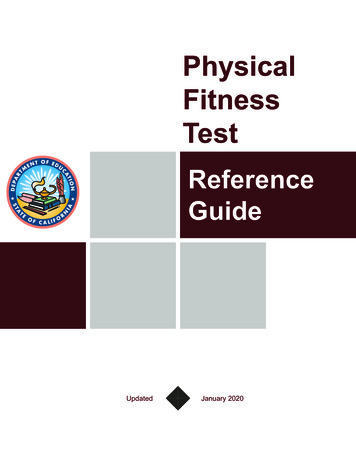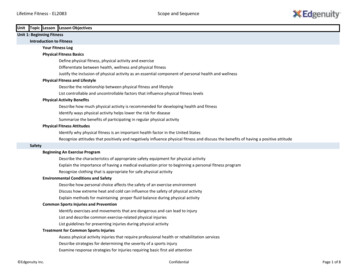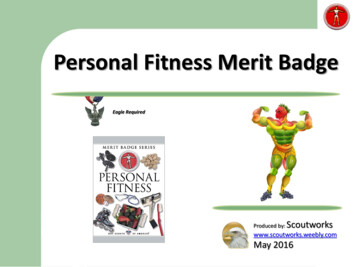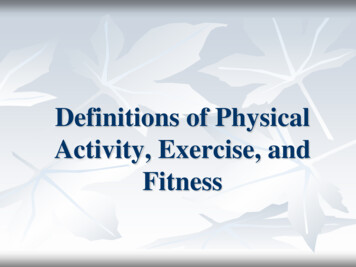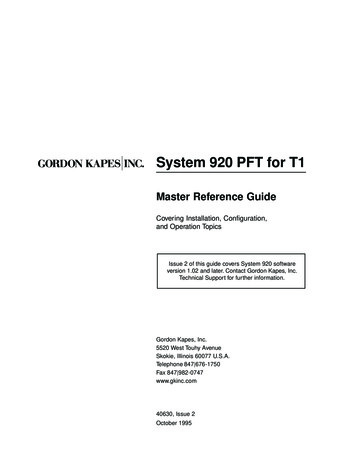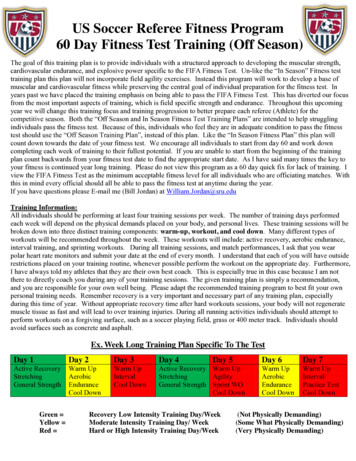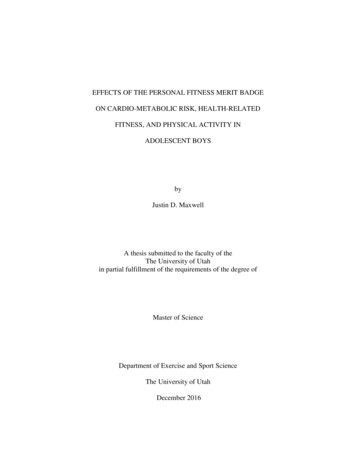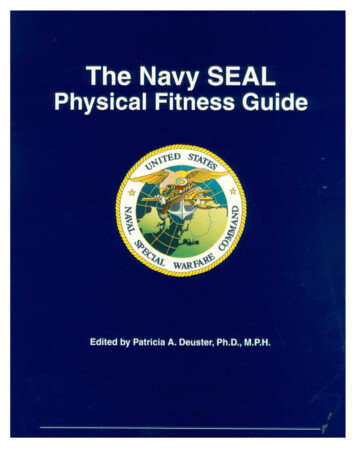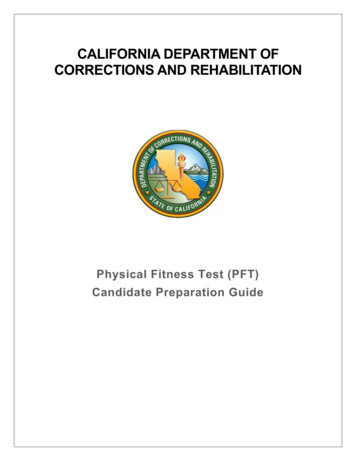
Transcription
CALIFORNIA DEPARTMENT OFCORRECTIONS AND REHABILITATIONPhysical Fitness Test (PFT)Candidate Preparation Guide
Correctional Peace Officers (CO, YCO, YCC) must be able to respond to a variety ofphysically demanding activities to maintain safety and security within a correctionalenvironment. The California Department of Corrections and Rehabilitation’s PhysicalFitness Test (PFT) evaluates each candidate’s strength, endurance, and agility related tothe essential duties and functions of Correctional Peace Officers. The PFT tests for thesame abilities required of Academy cadets and in performing various physical functionsonce assigned to their institution or facility.This 30-day training program was developed to help you prepare for the PFT and maintaina level of health consistent with the job duties of the position you are attempting to secure.As a Peace Officer, an above-average level of fitness is necessary for optimal jobperformance. The test is administered in a non-medical environment by non-medical staff.Therefore, it is in your best interest to evaluate objectively your level of physical fitnessand to prepare yourself prior to participating in the Physical Fitness Test.Exercise is vital for a healthy lifestyle. A dynamic exercise program should includeendurance training, strength training, and flexibility training. Exercise, however, is notwithout its risks and this or any other exercise program may result in injury. Consult aphysician or seek professional medical advice before beginning or changing an exerciseprogram. Persons who undertake this training program do so at their own risk.Discontinue your workout if you believe conditions to be unsafe. If you begin to feel faint,dizzy, or experience pain, you should stop immediately and consult a medicalprofessional.To assess the abilities required for Correctional Peace Officer, you willbe required to: Run a 500-yard course (approximately) on a variety of different surfaces, including:o Ascending and descending one flight of stairso Completing a mini obstacle courseCarry two (2) 45-pound hand-held weights over a distance of 50 yards and setthem down;Carry one (1) 45-pound weight over 75 yards and set it down;Carry one (1) 30-pound weight over a final distance of 110 yards and set it downTo be successful in the PFT, candidates must complete the combined course elementslisted above in no more than 5 minutes and 5 seconds.Candidates who have not engaged in recent physical activity or are significantly overweight may need more time to prepare for the PFT. Please consult with your physicianor medical professional to determine if you are healthy enough to begin this trainingprogram and a safe level of exercise intensity.1
Training Program for the Physical Fitness TestWarm-up and Stretching GuideYou should always begin an exercise session with an appropriate amount of timeallocated to warming up and stretching. A warm-up prior to training stimulates thecardiovascular system and various muscle groups, which increases performance andsignificantly reduces your risk of injury.Your warm-up should increase your core and muscle temperature without causingfatigue. To warm up, walk briskly, march, jog slowly, do steps, ride a bike, etc. Begin at aslow pace and then gradually increase the intensity. As a general rule, 5 to 10 minutes issufficient.It is best to stretch after warming up. The goal of stretching is to develop and maintain anappropriate range of motion around specific joints. Move slowly when stretching andstretch to the point of mild tension in the muscle or tendons. Hold the stretch for 15 to 30seconds for each muscle group. Below are some stretching recommendations:STANDING QUADRICEPS STRETCHFrom a standing position, reach back tograsp your right ankle with your right handand pull your foot toward your buttocks.Place your other hand on a wall or chair ifyou need balance and support. Repeatwith the left leg.STANDINGSTRETCH(LEGUP)HAMSTRINGStand upright and raise one leg onto asturdy object. Keep that leg straight andyour toes pointing straight up. Leanforward while keeping your back straight.Repeat with the other leg.2
STANDING CALF STRETCHStand about an arm's-length from a wall.Lean forward and place both hands on thewall about shoulder width apart. Extendone foot (the side to be stretched) behindyou with heel on the ground and one footcloser to the wall. Lean into the wall withyour hips until you feel a stretch in the calfof the extended leg. Repeat with the otherleg.LOWER BACK (KNEE TO CHEST)STRETCHLie on your back and bring one knee toyour chest. Hold the knee with both handsand gently pull in. Alternate knees andrepeat.TRUNK STRETCHStand with your feet shoulder width apart.Reach your right arm overhead and bendto the left at the waist. Repeat on oppositeside.CHEST STRETCHStand with your feet shoulder width apart.Clasp your hands behind your back andgently press your arms upward, keepingyour arms straight.3
SHOULDER STRETCHStand with feet shoulder width apart.Raise your right arm parallel to the groundand bring it across your chest holding itbelow the elbow with your other hand.Repeat with opposite arm.TRICEPS STRETCHRaise one arm straight up, so your upperarm is near your ear. Bend at the elbowand let your hand fall to the back of yourneck. With the other arm, reach behindyour head and place your hand on top ofthe bent elbow. Gently pull down and backon the elbow. Repeat with the other arm.WRIST (EXTENSION/FLEXION)STRETCHExtend your left arm straight out in front ofyou, Gently pull your fingers backwardswith your right hand, fingers pointingupwards (extension), until you feel astretch along the bottom of your arm andthrough your wrist. Now, with your palmdownward (flexion), with the right hand,grasp the fingers of the left hand and pullback gently, stretching the wrist andforearm. Repeat with the right arm.4
Endurance TrainingObjective: Run a 500-yard course (approximately) on a variety of different surfacesincluding up and down one flight of stairs.Endurance/Aerobic exercise is any sustained physical activity that increases yourrespiration (breathing) and heart rate. It strengthens your heart and lungs and trains yourcardiovascular system to manage and deliver oxygen more quickly and efficientlythroughout your body.Note: This training program a run/walk-to-continuous-running program designed to buildup your ability to run a mile. Each week, you will make a slight increase to your runningdistance and a decrease in your walking distance. By the end of four weeks, the target isto run one mile without stopping. The main objective is to build up your running distanceat a pace fast enough to complete the PFT course within the required time.1. We recommend to perform these workouts on a high school or college track (onelap is approximately 1/4 of a mile) or a treadmill that displays distance. Eachworkout described below provides the track equivalent to help gauge distances.2. Warm up for about 5-10 minutes with light aerobic exercise before the run (refer tothe “Warm-up and Stretching Guide” above).3. When you begin your run, do not start out racing. Instead, jog slowly and graduallybuild up your speed. If you feel yourself getting short of breath, slow down.4. After you finish your run, cool down by walking or slowly jogging for 5 to 10 minutes.Week 1 Day 1: Run 1/16 (0.06) mile, walk 3/16 (0.20) mile –(Track equivalent: Run 1/4 lap, walk 3/4 lap – repeat 4 times)Day 2: Cross-Training (alternative exercises)Day 3: Run 1/16 (0.06) mile, walk 3/16 (0.20) mile –(Track equivalent: Run 1/4 lap, walk 3/4 lap – repeat 4 times)Day 4: RestDay 5: Run 1/16 (0.06) mile, walk 3/16 (0.20) mile –(Track equivalent: Run 1/4 lap, walk 3/4 lap – repeat 4 times)Day 6: Cross-Training (alternative exercises)Day 7: Restrepeat 4 timesrepeat 4 timesrepeat 4 timesWeek 2 Day 1: Run 1/8 (0.12) mile, walk 1/8 (0.12) mile – repeat(Track equivalent: Run 1/2 lap, walk 1/2 lap – repeat 4 times) Day 2: Cross-Training (alternative exercises) 54times
Day 3: Run 1/8 (0.12)mile, walk 1/8 (0.12)mile – repeat 4 times(Track equivalent: Run 1/2 lap, walk 1/2 lap – repeat 4 times)Day 4: RestDay 5: Run 1/8 (0.12)mile, walk 1/8 (0.12)mile – repeat 4 times(Track equivalent: Run 1/2 lap, walk 1/2 lap – repeat 4 times)Day 6: Cross-Training (alternative exercises)Day 7: RestWeek 3 Day 1: Run 3/16 (0.20) mile, walk 1/16 (0.06) mile – repeat 4 times(Track equivalent: Run 3/4 lap, walk 1/4 lap – repeat 4 times)Day 2: Cross-Training (alternative exercises)Day 3: Run 3/16 (0.20) mile, walk 1/16 (0.06) mile – repeat 4 times(Track equivalent: Run 3/4 lap, walk 1/4 lap – repeat 4 times)Day 4: RestDay 5: Run 3/16 (0.20) mile, walk 1/16 (0.06) mile – repeat 4 times(Track equivalent: Run 3/4 lap, walk 1/4 lap – repeat 4 times)Day 6: Cross-Training (alternative exercises)Day 7: RestWeek 4 Day 1: Run 1 mile (Track equivalent: 4 laps 1 mile)Day 2: Cross-Training (alternative exercises)Day 3: Run 1 mile (Track equivalent: 4 laps 1 mile)Day 4: RestDay 5: Run 1 mile (Track equivalent: 4 laps 1 mile)Day 6: Cross-Training (alternative exercises)Day 7: Rest6
Cross-Training Recommendations (alternative exercises)*1. Walk/jog/run at intervals for a minimum of 20 minutes, alternating your pace. Forevery minute with a challenging pace, recover for 1 minute at a slower, easy pace.Hill running is also very effective. Run up a hill with a steepness that provides asignificant challenge as tolerated, then walk down and repeat.2. Stairs or bleacher running. Go up and down the stairs at a fast pace for 1 minute;recover for 1 minute at a slower pace. Repeat for a minimum of 20 minutes.3. Join a step aerobics class progressing to a higher step height as tolerated.4. Ride a stationary bike with a medium resistance for a minimum of 20 minutes.5. Ride a stationary bike in intervals of 5 minutes with easy resistance followed by achallenging resistance for 1 minute. Repeat this interval for a minimum of 20minutes.6. Ride a road or mountain bike on a level ground for 5 to 10 minutes, and then selecta hill to climb that provides a very challenging effort for several minutes and thencool down for 5 to 10 minutes on a level ground.7
Strength Training**Objective: Carry various weight loads up to 45 pounds in each hand over defineddistances.Progressive strength training promotes continuous adaptation over repeated bouts ofexercise to increase strength and/or endurance. Some exercises listed below requireequipment typically found in a gym. If you cannot obtain a gym membership, selectexercises that utilize body weight such as push-ups, sit-ups, body weight squat, andrunning. Resistance training consists of the number of times you perform a lift withoutstopping (repetitions) and how many times you repeat that lift (sets) separated by short(1-2 minute) recovery periods.Note: It is essential that you have adequate leg, abdominal, lower back, and grip strengthto be prepared for the PFT.1. Perform 2-3 sets of squats with resistance that fatigues your muscles between 8 to 12repetitions.2. Perform 2-3 sets of leg press with resistance that fatigues your muscles between 8 to12 repetitions.3. Perform 2-3 sets of abdominal crunches or sit-ups for 15 to 20 repetitions.4. Perform 2-3 sets of back extensions for 15 to 20 repetitions.5. Squeeze a hand grip exercise device near maximum effort for 15 seconds, rest for 60seconds; repeat 6 times.6. Squeeze a tennis ball near maximum effort for 15 seconds, rest for 60 seconds; repeat6 times.7. Hang from a chin-up bar until fatigued or as tolerated, rest for 60 seconds; repeat 6times.8. Carry two 45-pound weights in each hand for at least 60 seconds or walk at least 50yards; rest for 60 seconds and try to repeat 3 times.9. Note: If the 45-pound weights are too heavy to complete the task, start at a lighterweight and progressively increase the weight each week. For example, start Week 1using 30-pound weights. Try to add 5 pounds to each side each week. By Week 4,see if you can complete the exercise using 45-pound weights.8
Agility Training***Objective: Complete a mini obstacle course consisting of maneuvering around conemarkers and jumping over bench step barriers.Note: Agility is the ability to move quickly while changing direction and negotiatingobstacles. Agility training will help improve your coordination, balance, and speed.1. Cone DrillsThree Cone Drill – Place 3 cones forming a 90-degree angle about 20 feet apart. Startingat cone 1, sprint to cone 2. Round cone 2, sprint back to cone 1, round cone1, then sprintto cone 3, round cone 3 and sprint back past cone 1. Repeat 2-3 timesper session. Perform2 times per week.Four Cone Cross Pattern – Place 4 cones in a square pattern about 10 feet apart at eachside. Starting at cone 1, run to and around cone 2, then around cone 3, then aroundcone 4,and then back to cone 1 (follow the arrows and cones in order). Repeat 2-3 times persession. Perform 2 times per week.9
Three Cone Sprint Drill – Place 3 cones to form a tall, narrow triangle with a height ofabout 5 yards. Start at cone 1. Sprint to and around cone 2. Sprint to and around cone 3.Sprint strait to finish line vertically from cone 3. Walk or jog back to cone 1. Repeat 2-3times per session. Perform 2 times per week.2. Box Jump DrillsA box jump is simply jumping onto a box. To perform it correctly you should select abox height that challenges your jumping ability rather than requiring excessivehip flexibility to complete the jump successfully. Perform and practice 2 times perweek, 2-3 sets of 10 repetitions.10
3. Plyometric JumpsPlyometric jumps - Stand with your feet shoulder width apart. Drop into a squatand jump as high and far forward as you can. After you land, immediately repeatthe leap forward. Perform and practice 2 times per week, 2-3 sets of 10 repetitions.Note: All PFT tests are pass/fail and the same standards apply to all candidates.CALIFORNIA DEPARTMENT OF CORRECTIONS AND REHABILITATIONOFFICE OF PEACE OFFICER SELECTIONTESTING UNIT11
the bent elbow. Gently pull down and back on the elbow. Repeat with the other arm. WRIST (EXTENSION/FLEXION) STRETCH Extend your left arm straight out in front of you, Gently pull your fingers backwards with your right hand, fingers pointing upwards (extension), until you feel a stretch along the bottom of your arm and through your wrist.

